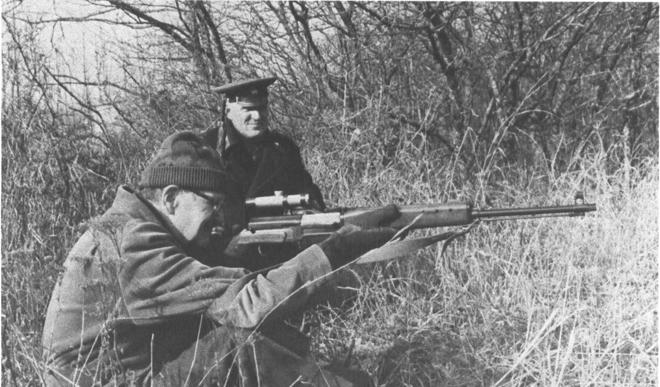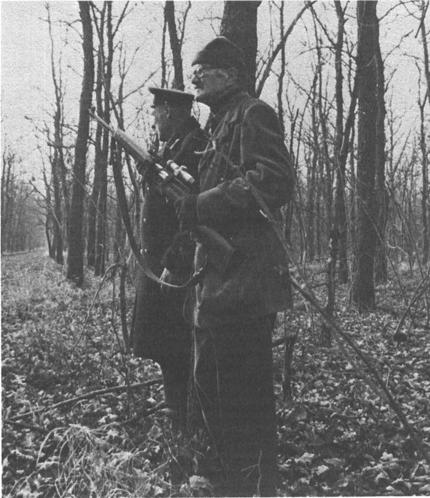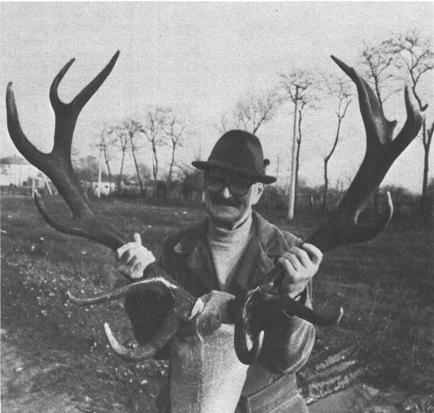
When we reached Krasnodar in the afternoon, a city of some 150,000, we were met by the forestry people and took off in a couple of Pobeda cars to the hunting lodge, some 200 kilometers away. We arrived there too late for any hunting, but we were set down to an excellent dinner, a lot better than we'd had on the train. After much good talk and almost as much drinking (Jim again proved his prowess), we hit the hay – we'd be going hunting early in the morning.
The weather had improved markedly, this far south – we awoke to a sunny sky, the temperature a cool 40 degrees F. or so, and little wind. Our guides and beaters were assembling as we stepped outside, and we had our first look at the guns we'd be using on the stags. These were 18-inch barreled 3-shot autoloading carbines, the magazine/guard hinged at the front to drop down for loading.
Loading was a little tricky, even for the guides on occasion – the cartridges had to be forced into the magazine lips from directly above – which was awkward – or fed through the receiver from the top and on into the rear of the magazine. The Medved carbine is gas-operated, the slender actuating rod free-floating and lying above the barrel.
 Amber takes practice aim with the Medved 9.3 carbine, his be-capped and uniformed forester looking on. |
 The drive has started. My forester/guide and I can hear the distant shouts and calls of the beaters. |
The cartridges, we were told, were 9mm, and that's all anyone there knew about them; muzzle velocity, bullet weight, trajectory figures were unknown. Subsequent checking showed this load to be, in fact, a 9.3mm, a Russian round derived from the Finnish 9.3×53 Rimmed, with power about like the 35 Remington.
Even in bright sunlight a sheet of flame a foot long was easily visible at the muzzle whenever these Medved carbines were fired! Though I had indicated early on that I'd need a scope, one had to be sent for, which didn't take long, happily – the long train ride had lost us a day or more of hunting time, as would the return trip to Moscow, a 29-hour stretch.
The straight-tube scope, which appeared to be about 2x, had a very narrow field of view. The reticle was, of course, the beloved European type – a sharply-pointed broad post with a thick bar coming in from either side.
A target was set up about 70 yards away, and each of us – as required in European hunting everywhere – managed to connect adequately with it.
Russian Red Deer
The Red Forest, a vast acreage of hardwoods and deciduous trees, was entirely leafless, affording us no cover. Most boles were only about 8 inches in diameter, and when the stags did appear they had scented or seen us well before.
Nearly all shots had to be made by aiming up or down the numerous cart tracks. Fortunately there was no shortage of deer – we must have seen hundreds, many of them great stags, but often too far away for the fire-belching 9.3mm loads. In our day-and-a-half of hunting five excellent deer were killed by us foreigners, plus another by our escort, Andrei Stepoura, and two or three more by the head forester and his son.
We could have shot others, of course – hunting is a commercial operation in much of Russia, and we were told that the 1978 quota for the Red Forest area would necessitate the shooting of a few dozen more stags and cows. Some 45 deer were taken during the regular season. Two of our stags came close to making the Gold Medal class (in the CIC European system) but all were noble beasts, both in body size and racks. Dewey Thorns was the first to score, then came Barlow and Carmichel; your aging scribe came last, and about at the last.
 John Amber with his red deer. The trophy is both large and heavy. It lacks symmetry in the crown area, but scores well in any league. |
No question, the stag hunting was excellent indeed in the Red Forest in spite of non-ideal conditions. Had there been thick cover, as would have prevailed in September or early October – when we were supposed to have hunted – I'm sure we'd have done even better.
Fearing red tape and border-crossing problems, not to mention the chore of lugging four rifles around Europe, we didn't bring our favorites into Russia. We wished we had, though, and as we learned, there'd have been no trouble.
The 9.3mm round is about a 150-yard load, and I gazed at my guide in wonder the first morning as we spotted several stags walking in single file some 350 meters away (the guide's guess, not mine) on the far side of a great open meadow.
“Shoot,” he told me as I didn't even bother to raise the carbine, so I shot – a guide's command in Europe is just about that. I held a good couple of feet over the deer's shoulder, but I missed. I probably dropped that bullet about as much under the deer's belly as I'd held over.
All too soon the stag party was over – the company and the food had been excellent, and Carmichel was learning to curse in Russian. That was fair enough; he'd taught the Tula engineer a rough phrase or two in English.
 If you enjoyed the quality of this article, you can't miss your chance to get the new Gun Digest 1944-2009 3-DVD Set — containing 65 years of Gun Digest books in digital format.
If you enjoyed the quality of this article, you can't miss your chance to get the new Gun Digest 1944-2009 3-DVD Set — containing 65 years of Gun Digest books in digital format.
This new 3-DVD set includes all of the previous 63 editions of the Gun Digest annual, from 1944 to 2009. Nearly all of these editions are out of print and are very rare and difficult to find.

![Best Concealed Carry Guns In 2025 [Field Tested] Wilson Combat EDC X9S 1](https://gundigest.com/wp-content/uploads/Wilson-Combat-EDC-X9S-1-324x160.jpg)


![Best 9mm Carbine: Affordable PCCs [Tested] Ruger Carbine Shooting](https://gundigest.com/wp-content/uploads/Ruger-Carbine-Shooting-100x70.jpg)
![Best AR-15: Top Options Available Today [Field Tested] Harrington and Richardson PSA XM177E2 feature](https://gundigest.com/wp-content/uploads/Harrington-and-Richardson-PSA-XM177E2-feature-100x70.jpg)
